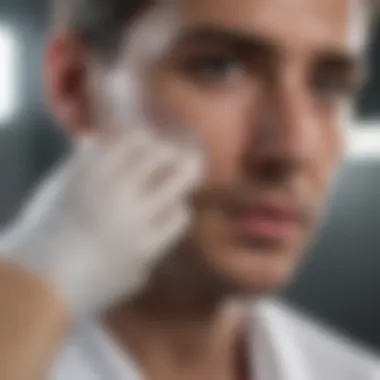Innovative Bandages Enhancing Healing


Overview of Research Topic
Brief Background and Context
The evolution of bandage technology reflects a significant shift in how we comprehend and address the complexities of wound healing. Historically, bandages were mere tools to cover injuries, primarily focusing on physical protection against contaminants. However, recent advancements have transformed them into sophisticated devices that actively contribute to the healing process. With new materials and designs emerging, the potential of bandages has expanded, indicating a need for deeper exploration of their mechanisms and applications. This transition not only presents opportunities for improved patient outcomes but also positions bandages as pivotal players in modern medical practice.
Importance in Current Scientific Landscape
In today’s medical landscape, the significance of advanced bandages cannot be overstated. With an aging population and an increase in chronic wounds, healthcare professionals are continuously seeking innovative solutions to accelerate healing and enhance patient comfort.
- Infection Control: Many of these advanced bandages feature antimicrobial properties, which are crucial in preventing infections in vulnerable patients.
- Moisture Management: Maintaining optimal moisture levels is instrumental for healing, and modern bandages innovate in materials that facilitate this while also allowing for gas exchange.
- Cost-Effectiveness: Efficient wound management not only saves time and resources but also can lessen the financial burden on healthcare systems.
The exploration of these elements within bandage technology is not just timely; it exemplifies an essential crossover between materials science and healthcare, illustrating an exciting trajectory that promises to revolutionize patient care.
Methodology
Research Design and Approach
To navigate the complex world of advanced bandages, a multifaceted research design was adopted, incorporating both qualitative and quantitative methods. This dual approach allowed for a comprehensive analysis of the products on the market, their proven efficacy, and emerging trends within the field.
- Literature Review: A thorough review of recent publications provided a foundational understanding of current technologies, inclusive of biochemical interactions associated with various materials.
- Case Studies: Key case studies highlighted in real-world applications, capturing the practical impacts of these advanced solutions on patient outcomes.
Data Collection Techniques
Data collection was primarily driven by:
- Surveys and Interviews: Engaging with healthcare professionals offered insights into real-life applications and patient experiences.
- Clinical Trials: Reviewing findings from clinical trials enabled a closer look at the performance metrics of advanced bandages against traditional alternatives.
- Market Analysis: Identifying market trends not only aids in understanding current consumer options but also forecasting the direction of future developments in bandaging technologies.
Through these meticulously structured methods, the exploration revealed rich insights into how novel bandaging approaches can enhance healing processes. As technology progresses, so too does the potential for improving lives through better wound management.
Preamble to Healing Bandages
The field of wound care is changing, and bandages play a vital role in this evolution. Healing bandages are more than just strips of fabric. They embrace a crucial function in managing wounds, promoting healing, and preventing complications. Understanding these advancements is essential for students, researchers, educators, and healthcare professionals, who seek deeper insights into the available options today.
In the world of medicine, effective dressing can make a world of difference. The right type of bandage can not only protect against infections but also create optimal environments for healing wounds, allowing the body to do its job unhindered. This article aims to provide a comprehensive look into the importance of healing bandages, detailing their development, significance in various medical contexts, and their transformative effects on patient outcomes.
Historical Context
Bandaging as a practice dates back to ancient times. Initially, early healers utilized materials found in their environment. Egyptians, for instance, used linen or rags soaked in oil to dress wounds, while the Greeks had their own methods which involved animal hides and herbs. Over the centuries, as our understanding of medicine grew, so too did our approach to wound care. By the 16th century, concepts of antisepsis were introduced, leading to the development of more sophisticated dressings.
It wasn't until the late 20th century that innovations such as hydrocolloids and foams came into play, changing the landscape of wound management. This historical progression is significant, for it reflects a constant journey towards improving patient outcomes. Each era has contributed pieces to the puzzle of effective healing and presented opportunities for further exploration.
Importance of Bandaging in Medicine
Bandaging may seem like a straightforward task, but its importance cannot be overstated. A proper bandage serves several key purposes:
- Infection Prevention: By covering a wound, bandages protect it from bacteria, dirt, and external contaminants.
- Moisture Retention: Certain types of bandages maintain a moist environment crucial for cellular activity, which accelerates healing processes.
- Pain Reduction: Quality bandages can minimize pain from friction and pressure that wounds often experience.
- Enhanced Recovery: With the right choice of dressing, the body can heal more efficiently, reducing potential complications.
"The choice of bandage can drastically influence healing time and overall wound management success."
Appropriate bandaging techniques, coupled with specialized dressings, underline the medical profession's commitment to improving patient experience. For practitioners and patients alike, staying informed about up-and-coming dressing technologies is less of a luxury and more of a necessity in today's clinical landscape.
Understanding Wound Healing
Wound healing is an intricate process, vital not just for restoring skin integrity but also for preventing infections and other complications. It involves a series of biological events that unfold in phases, governed by various physiological factors. This section sheds light on the nuanced characteristics of these phases and the external factors influencing the healing trajectory. A grasp of these elements enhances our understanding of how advanced bandaging technologies can facilitate and enhance the recovery process.
Phases of Wound Healing
The wound healing process is generally characterized by distinct phases, each playing a crucial role in achieving optimal recovery. The four recognized phases are Hemostasis, Inflammation, Proliferation, and Maturation. Let's break down these phases further to appreciate their unique contributions.
Hemostasis
Hemostasis marks the very beginning of the wound healing process. This phase is characterized by the body’s immediate response to injury, where blood vessels constrict to minimize blood loss. Platelets aggregate, forming a clot that serves as a temporary barrier against pathogens. This characteristic is essential because it lays the groundwork for subsequent healing phases. The unique feature of hemostasis is its speed; it typically occurs within minutes of injury. However, while hemostasis is vital, excessive clot formation can sometimes compromise healing if not regulated properly.
Inflammation
Following hemostasis, inflammation kicks in, often recognized by redness, heat, swelling, and pain. This phase is crucial as it signifies the body’s immune response to clear the wound of debris, bacteria, and damaged tissues. The primary characteristic of inflammation is the influx of white blood cells, which plays a vital role in wound defense. While inflammation is essential for initiating healing, chronic inflammation can prolong recovery, highlighting its dual nature as both beneficial and potentially detrimental.
Proliferation
The proliferation phase is where the magic really begins. This is the stage where new tissue, including collagen and blood vessels, starts forming, filling the wound gap. One key characteristic of this phase is angiogenesis, which helps supply nutrients to the new tissue, essential for its growth. Proliferation is beneficial because it actively works to close the wound, enhancing the area’s integrity. However, the unique feature here is its reliance on factors such as oxygen levels; insufficient oxygen supply can hinder optimal tissue regeneration.
Maturation
The last phase, maturation, can take weeks, months, or even years to fully develop. During this period, new tissue gains strength and flexibility as the wound undergoes remodeling. Collagen fibers are realigned, and the overall wound site matures, becoming less vascularized. The primary characteristic of maturation is its slow evolution, which is beneficial as it solidifies the healing achieved in previous phases. A downside to this phase is the possible formation of scar tissue, which can sometimes be aesthetically or functionally undesirable.
Factors Influencing Healing
Healing does not occur in a vacuum; several external and internal factors can significantly influence recovery. Understanding these variables is crucial for enhancing the effectiveness of advanced bandaging techniques. Key factors in this regard include Age, Nutrition, and Comorbidities.
Age
Age plays a substantial role in wound healing. Younger individuals tend to heal faster due to better cellular regeneration and immune response. The unique feature of age's influence is that older adults often experience delayed healing due to reduced skin elasticity and slower cellular processes. While advanced bandages can aid in healing, they may not fully counteract age-related declines in recovery efficiency.
Nutrition
Nutritional status is another significant determining factor in how well wounds heal. Proper intake of vitamins, minerals, and proteins is essential for tissue repair. A key characteristic of this aspect is that malnutrition can dramatically impede healing processes. Advanced bandages may support recovery, yet they cannot substitute for a balanced diet, underscoring their role as adjuncts rather than replacements in treatment.


Comorbidities
The presence of various health conditions, such as diabetes or cardiovascular disease, can complicate the healing process. These comorbidities may affect circulation, immune response, and overall recovery time. A unique feature here is that some bandages might be specifically designed to cater to certain conditions, like diabetic foot ulcers, which emphasizes the need for tailored approaches in wound care. However, such specificity can limit the universal applicability of these advanced products across different wound types.
Types of Healing Bandages
Understanding the various types of healing bandages is crucial for anyone involved in wound care. Each type is designed with specific materials and features that aim to create an optimal environment for healing. From minor cuts to severe wounds, the choice of bandage can significantly influence recovery times and the risk of infection.
In this section, we'll delve into four prominent types of healing bandages: hydrocolloid bandages, foam dressings, alginate dressings, and hydrogel bandages. Each type presents unique attributes and benefits that cater to different healing needs.
Hydrocolloid Bandages
Hydrocolloid bandages are a popular choice due to their ability to maintain a moist environment around the wound. Made from a combination of gelatin and other components, these bandages are both flexible and absorbent. They form a gel-like covering as they interact with wound exudate. This moisture helps speed up the healing process, reduces pain, and minimizes scarring.
Key benefits of hydrocolloid bandages include:
- Moisture retention: Keeps the wound hydrated, promoting faster healing.
- Pain relief: Reduces discomfort from friction and exposure to air.
- Barrier protection: Shields the wound from external contaminants, decreasing infection risks.
One point to consider is that hydrocolloid bandages may not be suitable for all types of wounds, especially those with high levels of drainage, as this can lead to leakage and skin maceration around the edges.
Foam Dressings
Foam dressings represent another vital category in healing bandages. These are made with a polyurethane foam, which is soft and provides excellent cushioning. They are particularly useful for managing heavily exuding wounds due to their high absorbency.
Advantages of foam dressings include:
- Shock absorption: Protects the wound from mechanical trauma.
- Thermal insulation: Maintains an optimal temperature at the wound site.
- Easy application: Typically come with adhesive backing for simple placement.
However, healthcare providers must ensure that foam dressings are changed regularly to prevent build-up of exudate, which could lead to a potential environment for bacterial growth.
Alginate Dressings
Alginate dressings are derived from seaweed, making them a popular option for their natural properties. They are designed to absorb large amounts of exudate while also promoting a moist healing atmosphere. When in contact with moisture, alginates transform into a gel, which aids in creating a conducive environment for healing.
Key features include:
- High absorbency: Ideal for wounds with moderate to heavy exudate.
- Biocompatible: Low risk of allergic reactions for most individuals.
- Hemostatic properties: Can assist in controlling bleeding by enhancing clot formation.
Nonetheless, alginate dressings can be somewhat bulky, which may not be ideal for superficial or dry wounds. Selecting the right dressing involves understanding the specific needs of the wound.
Hydrogel Bandages
Hydrogel bandages are excellent for dry or necrotic wounds, as they contain water-based gels that provide moisture directly to the wound. They help in autolytic debridement, which is the body's natural process of removing dead tissue.
Benefits of hydrogel bandages are:
- Hydration boost: Excellent for dry wounds, allowing for faster healing and comfort.
- Transparency: Many hydrogel options are transparent, allowing regular monitoring without removing the dressing.
- Cooling effect: Provides pain relief during application due to their intrinsic cooling properties.
Despite their advantages, hydrogel bandages may not be ideal for draining wounds, as they lack the absorbency necessary to handle excess fluid.
Mechanisms of Action
Understanding the mechanisms of action behind bandages that promote healing is crucial for both healthcare professionals and patients. These mechanisms encompass a variety of physiological and biochemical processes that facilitate the body’s natural healing pathways. It's not just about covering a wound; it's about creating the ideal environment for skin repair, reducing complications, and ultimately speeding up recovery time.
Moisture Management
Moisture management plays a pivotal role in wound care. When a wound is kept moist, it helps maintain the ideal conditions for cellular migration and growth. This doesn’t mean leaving a wound soggy; rather, it's about creating a balanced aqueous environment.
- Benefits of moisture management include:
- Considerations:
- Enhanced Cell Migration: Moisture aids in the movement of epidermal cells across the wound bed, which is essential for closing the wound.
- Reduced Pain: Moist environments can lessen irritation and inflammation, resulting in less discomfort for the patient.
- Inhibition of Scab Formation: Scabs can impede healing, and managing moisture prevents this by keeping the surface hydrated.
- Choosing the right bandage is crucial. Hydrocolloid dressings, for instance, can trap moisture effectively while allowing exudates to be absorbed, reducing the risk of infection.
- Monitoring is also vital. Too much moisture can lead to maceration, so it’s a balancing act that must be managed actively.
Temperature Regulation
Temperature regulation is another significant factor in wound healing that cannot be overlooked. Wounds heal best in warm environments. Careful control of temperature can promote cellular functions that are essential for recovery.
- Why is it important? Keeping a wound at an appropriate temperature can help manage inflammatory response, enhance blood flow, and facilitate the mobilization of immune cells.
- Tools for regulation:
- Some advanced bandages come with built-in thermal features. These bandages can maintain an optimal temperature through innovative materials that reflect body heat.
- Using insulating materials prevents heat loss, perhaps similar to the way thermal blankets work for hypothermic patients. It’s a nuanced yet critical aspect of wound care.
Gas Exchange
Gas exchange often flies under the radar during discussions on wound healing. However, adequate oxygen supply is fundamental for effective healing. Oxygen is vital for cellular respiration, and its deficiency can compromise the metabolic processes involved in tissue repair.
- How do modern bandages facilitate this?
- Certain breathable dressings allow for adequate oxygen influx while still providing protection against pathogens. This airflow can be likened to cracking a window in a stuffy room—it allows fresh air in without letting outside elements disturb the peace.
- Elements that influence gas exchange include:
- Key benefits:
- Material Composition: Breathable materials, like polyurethane foams, can help facilitate oxygen exchange.
- Thickness of the Bandage: Thinner materials often enhance gas permeability.
- Prevents tissue hypoxia, where cells are deprived of oxygen, ultimately leading to improved healing outcomes.
- Creates a conducive atmosphere for microorganisms that are beneficial to healing while thwarting harmful pathogens.
"The effectiveness of modern bandages hinges on more than just coverage; they are scientifically designed environments that nurture the body’s own healing processes."
Taking these mechanisms into account allows healthcare providers to make informed decisions about which bandages to employ based on the unique context of each wound. Understanding moisture, temperature, and gas exchange not only enhances patient care but also fosters an environment where healing can flourish.


Advanced Materials in Bandage Technology
Advancements in bandage technology have become a pivotal factor in enhancing the healing process. The introduction of advanced materials into bandage design not only shifts the focus from mere protection to active healing but also addresses various clinical challenges faced by healthcare professionals. The importance of this topic cannot be overstated, as the right materials can drastically alter the outcome of wound healing, leading to improved patient care. Modern bandages must be designed to manage moisture, prevent infection, and promote tissue regeneration. Each novel material contributes unique benefits and presents specific considerations that clinicians need to understand for optimal application.
Nanotechnology in Bandages
Nanotechnology is revolutionizing the landscape of wound care. By manipulating materials at the molecular level, researchers have developed bandages that provide enhanced healing properties. These nanomaterials can deliver medication directly to the site of the wound, reducing the need for systemic administration and minimizing side effects. They also have properties that help with moisture retention and bacteria elimination. For instance, silver nanoparticles embedded in hydrocolloid dressings can offer significant antimicrobial effects, effectively reducing the risk of infection without harming healthy tissue.
- Enhanced drug delivery: Nanotechnology allows for sustained release of medications, ensuring that the drug concentration remains effective over time.
- Improved antimicrobial action: With the ability to combat infections, nanotech-infused bandages have become crucial in settings like surgical wards.
- Smart materials: These bandages can respond to changes in the wound environment, altering their properties to ensure optimal healing conditions.
Given the complexities of nanomaterials, further research is essential for understanding their long-term effects on human biology and ensuring safety.
Antimicrobial Agents
The use of antimicrobial agents in bandage technology represents a significant stride toward improving wound care. By integrating substances that prevent bacterial growth, these bandages mitigate one of the major risks associated with wound healing: infection. Antimicrobial dressings commonly feature ingredients like honey, iodine, and silver, each chosen for their ability to actively combat pathogens while supporting a moist wound environment.
Benefits of incorporating antimicrobial agents include:
- Infection control: Reducing bacterial load can lead to faster healing and fewer complications.
- Enhanced patient comfort: By minimizing infections, patients experience reduced pain and discomfort, aiding in recovery.
- Adaptability: Many antimicrobial materials offer flexibility, making them suitable for a variety of wound types.
Nevertheless, clinicians must exercise caution. Overreliance on antimicrobial dressings can lead to resistance if not used judiciously, a pressing concern that calls for balanced application in wound management protocols.
Smart Bandages
As technology advances, the concept of smart bandages emerges, representing the frontier of wound care innovation. These bandages are equipped with sensors and electronics, allowing them to communicate with healthcare providers regarding the status of the healing process. Smart bandages can monitor temperature, pH levels, and moisture, providing invaluable real-time data that assist practitioners in making better-informed decisions about patient care.
"Smart bandages not only protect the wound but also actively participate in the healing process by providing constant feedback on the wound environment."
Advantages of smart bandages include:
- Real-time monitoring: Continuous assessment of the wound can make a significant difference in early detection of complications.
- Personalized care: Information from smart bandages allows for tailored treatment plans, customizing care based on individual healing processes.
- Reduced healthcare visits: With better insight into healing, patients may require fewer in-person check-ups, streamlining treatment pathways.
In summary, advanced materials in bandage technology signify a remarkable stride forward in healthcare, particularly in wound management. The incorporation of nanotechnology, antimicrobial agents, and smart capabilities not only enhances healing processes but also promise a future where wound care is more efficient, effective, and patient-centered.
Clinical Applications
Clinical applications of healing bandages play a pivotal role in modern medicine. They bridge the gap between basic wound care and advanced healing methodologies. By tailoring the properties of bandages to specific types of wounds or injuries, healthcare professionals can significantly enhance the healing process, minimize patient discomfort, and reduce the risk of complications.
A deeper comprehension of how different bandage types suit various clinical scenarios can optimize treatment strategies. Key applications include burn treatments, chronic wound management, and post-surgical applications.
Burn Treatments
Burn injuries, whether they be from scalds, flames, or electrical sources, require immediate and sometimes specialized care. Bandages designed for burn treatment must prioritize not only healing but also pain management and infection prevention.
In this context, hydrocolloid and silicone-based dressings prove beneficial due to their ability to maintain a moist wound environment. This moisture is critical; it prevents the formation of a hard scab, which can impede healing and cause more pain. Moreover, some of these dressings can absorb exudate while simultaneously allowing gas exchange, nurturing the tissue underneath.
"Effective burn care can drastically reduce healing time and improve quality of life for patients."
A specific example includes the use of silver sulfadiazine cream along with moist dressings. Silver acts as an antimicrobial agent. The combination aids in keeping the wound clean and minimizes the chance of infection while promoting healing.
Chronic Wound Management
Chronic wounds—those that do not adhere to the normal cycle of healing—pose a significant challenge in clinical practice. Conditions such as diabetes and venous stasis ulcers often contribute to these lengthy healing processes. Bandages that cater specifically to chronic wounds must address underlying issues such as moisture balance and infection control.
In particular, alginate dressings stand out for their high absorbency and gel-forming capabilities upon contact with wound exudate. They help create the ideal environment for healing without annoying the surrounding skin. Moreover, foam dressings can also be employed for chronic wounds with varying exudate levels, further promoting healing while ensuring comfort.
Utilizing these specialized bandages leads to better management of chronic wounds – ultimately aiming for granulation and closure while keeping the patient’s pain to a minimum.
Post-Surgical Applications
Following surgery, proper wound care is crucial for recovery. The right bandage can reduce the risk of infection, promote healing, and improve overall outcomes. Post-surgical bandages should facilitate comfort, protection, and adequate ventilation.
For instance, smart bandages can provide real-time monitoring of wound conditions, signaling potential issues—including increased temperature or moisture levels. These high-tech dressings also reduce the need for constant nursing checks, allowing for more patient autonomy and comfort.
Also, it is important to consider the patient's mobility and lifestyle when selecting post-surgical bandages. Some patients may benefit from lightweight, flexible options that conform to their body and do not restrict movement.
In summary, whether treating burns, managing chronic wounds, or addressing postoperative care, the applications of advanced healing bandages are vast and crucial. Each type of bandage brings distinct advantages tailored to specific clinical scenarios, ultimately leading to improved healing outcomes.
Evaluation of Bandage Efficacy
Evaluating the efficacy of bandages plays a critical role in understanding how various designs and materials influence the healing process. It’s not just about slapping a band-aid on a wound. Instead, it involves a careful examination of various metrics that can inform healthcare professionals about the best approaches to wound treatment. The stakes can be high, considering that insufficient healing can lead to complications or prolonged patient discomfort. It's crucial for clinicians to base their decisions on solid evidence gathered from clinical trials and studies.
The evaluation process allows practitioners to differentiate between effective and less effective bandaging techniques, ensuring that patients receive the best care possible. It also aids in identifying the advanced bandage technologies that possess significant benefits over conventional options. This section will delve into the specifics of clinical trials that assess bandage performance, as well as the key metrics—namely healing time and infection rates—that gauge the success of these treatments.
Clinical Trials and Studies
Clinical trials serve as the backbone of establishing a bandage's efficacy. They involve systematic investigations designed to test how well a bandage can aid in wound recovery when compared to standard care or other advanced solutions. These studies often include a diverse patient cohort to better account for various variables affecting wound healing, such as age and comorbidities. Furthermore, randomized controlled trials—the gold standard in medical research—allow for unbiased comparisons and meaningful conclusions about how one bandage effectively works over another.
In these trials, factors like user-friendliness, ease of application, and the time it takes to change bandages are often critical points of evaluation. Clinicians and researchers analyze data to identify not just the effectiveness of a product, but also patient adherence to using it correctly. Ultimately, the findings from clinical trials help shape guidelines for best practices in healthcare settings and potentially lead to new standard treatments for wound care.
Metrics for Success
When discussing the evaluation of healing bandages, two significant metrics come into play: healing time and infection rates. Establishing a clear understanding of these metrics can uncover valuable insights about each bandage's performance.
Healing Time
Healing time is a crucial metric that draws attention when evaluating bandage efficacy. It indicates how quickly a wound can close and return to normal function, directly impacting patient recovery experiences. In many studies, shorter healing times are associated with the use of advanced bandage materials that maintain an ideal moisture balance. This moisture management can promote cellular activity, essentially aiding the body's natural healing processes.


One noteworthy characteristic of healing time is its ability to reflect not just the efficiency of the healing process but also the overall experience for patients. A quicker recovery often translates to reduced healthcare visits and associated costs. However, one unique feature of healing time is that it may not solely depend on the bandage. Factors like the type of wound, health status of the individual, and even their nutritional intake can influence outcomes.
Infection Rates
Infection rates stand as another indispensable metric in evaluating bandage efficacy. A lower infection rate signifies that a bandage not only protects the wound but also serves as a barrier against pathogens, thereby promoting a favorable healing environment. This characteristic is particularly critical in hospital settings, where patients would benefit from reduced post-operative infections.
For instance, bandages infused with antimicrobial agents can significantly lower the presence of bacteria around a wound. Such unique features make these advanced bandages stand out in clinical examinations.
Nevertheless, it's essential to view this metric with some caution. While an advanced bandage might minimize infection risk, various external factors—patient compliance, environmental cleanliness, and even underlying health conditions—can also sway the outcome. Hence, while infection rates provide substantial insight, they should always be interpreted in the broader context of patient care.
"The efficacy of a bandage can significantly influence not just the healing process, but the patient's overall experience during recovery."
Case Studies and Real-World Applications
In the landscape of modern medicine, the practical application of healing bandages transcends mere theory. Focusing on case studies and real-world applications reveals how these advanced materials are employed to effect tangible benefits in diverse clinical settings. By understanding how successful implementations happen, both students and professionals can glean valuable insights that foster innovation in patient care.
One notable element in this arena is the successful integration of these bandages in emergency medicine. Fast-paced environments necessitate quick and effective solutions that can directly impact patient outcomes. Bandages equipped with specialized properties—such as hemostatic capabilities or antimicrobial agents—allow medical professionals to respond promptly and effectively in critical moments.
Furthermore, the adaptability of these bandages plays a crucial role. For instance, during emergency trauma situations, practitioners can deploy smart bandages that monitor vital signs or detect infections in real-time, providing invaluable data that aids in decision-making. This kind of information could mean the difference between life and death, underlining the importance of advanced bandage technology.
Innovative Uses in Emergency Medicine
In emergency medicine, time is often of the essence. Bandages that promote rapid healing while mitigating the risk of infection can significantly improve patient outcomes. For example, in trauma care, hydrocolloid dressings are popular due to their moisture-retentive properties. They not only keep the wound hydrated, promoting faster healing, but also provide a barrier against external contaminants.
Additionally, organizations like the American College of Emergency Physicians have endorsed the use of hemostatic dressings in cases of severe hemorrhage. These dressings contain gelling agents that promote rapid clotting, which is crucial in life-threatening situations. Studies have shown that patients treated with such dressings experience a lower incidence of adverse events compared to traditional bandaging approaches.
"The practical application of advanced bandage technology in emergency situations exemplifies how innovation can save lives."
Veterinary Medicine Applications
The principles of wound care and healing extend beyond human medicine, impacting veterinary practices as well. Animals, much like humans, require effective wound care solutions that can adapt to their unique physiological needs. Veterinary medicine has seen a surge in the adoption of advanced bandaging materials, particularly in treating sports injuries in pets or surgical recovery in livestock.
For instance, alginate dressings have become a go-to choice in veterinary clinics. Made from seaweed, these dressings can absorb excess exudate while promoting a moist wound environment—ideal for encouraging healing in chronic wounds often found in dogs and horses.
Moreover, transdermal patches infused with anti-inflammatory properties have shown promise in alleviating pain and supporting healing in various animal species. Research indicates that the effectiveness of these patches can achieve results comparable to traditional oral medications, yet with fewer complications. Such innovations highlight not only the benefits brought forth by advanced bandaging technologies but also their versatility across different fields of medicine.
As we forge ahead, these case studies not only showcase proven applications but also serve as a foundation for future research. The potential of specialized bandages is vast, with ongoing studies promising even greater advances in patient care.
Future Directions
The realm of healing bandages hasn’t just reached a standstill; it’s on the verge of an exciting evolution. In a world where rapid advancements in technology closely follow each other, the future of bandaging is painted with potential that could redefine patient care. As we look forward, several specific elements emerge, highlighting the tangible benefits and considerations that surround this topic.
First off, the integration of cutting-edge materials in bandage design promises enhanced healing capabilities. Imagine bandages that can monitor wound conditions in real-time and adjust their properties accordingly! This is not mere speculation; ongoing research is already pointing in this direction, with new materials emerging that can react to changes in the wound environment.
Ongoing Research and Development
Research is continuously bridging the gap between theoretical concepts and practical applications. For instance, scientists are exploring biodegradable bandages made from natural polymers like chitosan and alginate. These materials are not just eco-friendly; they have intrinsic antibacterial properties that guard against infections. Furthermore, nanotechnology is making ripples in this field.
Recent studies suggest that nanofibers can significantly improve cellular interactions, leading to faster wound closure. The beauty of this research lies in its dual purpose: enhancing healing while reducing environmental impact. As organizations and institutions ramp up these efforts, it becomes increasingly clear that staying updated with current research findings will be imperative for healthcare professionals.
Potential for Personalized Medicine
The concept of personalized medicine is gaining traction, and in the context of bandaging, the implications are profound. Each patient's body, injury type, and healing rate are unique, suggesting that a one-size-fits-all solution for wound care may not suffice. Instead, the future may lie in tailored bandage solutions designed to meet individual needs.
By leveraging patient data — including genetics, underlying health conditions, and past healing experiences — healthcare providers can craft bandaging strategies that align with patients' specific profiles. This not only optimizes the healing process but also substantially reduces the risk of complications.
"Personalized approaches can lead to improved outcomes, tailoring treatment based on real needs rather than generalized methods."
Finale
The insights garnered from this exploration of healing bandages are not only of academic interest but also of practical significance in the realm of patient care. Bandaging practices have evolved remarkably; they now incorporate advanced materials and technologies that play a decisive role in wound healing. Understanding how these bandages function highlights their importance in modern medicine, emphasizing that effective management of wounds can lead to quicker recovery.
Key elements such as moisture management, targeted drug delivery, and antimicrobial properties have been discussed in full. Each aspect contributes to a holistic approach toward wound care, showcasing how intricately designed bandages serve more than just a protective purpose. They are pivotal in minimizing pain, reducing infection risks, and accelerating healing times.
As we think about the future, considerations abound. It's critical for both practitioners and patients to grasp the abilities of various bandaging options, enabling informed choices that cater to unique healing needs. The implications of adopting these advanced bandaging technologies stretch beyond individual patient outcomes; they set the stage for improved healthcare standards overall.
"The evolution of bandaging technology signifies a shift towards more personalized and efficient healing strategies in healthcare."
By striving to integrate these insights into everyday practices, healthcare professionals can significantly enhance patient experiences and outcomes.
Summary of Key Points
- Historical Development: The article traced the progression from traditional bandaging methods to contemporary advancements.
- Mechanisms of Action: Moisture retention and temperature regulation are among the key functions that promote the healing process.
- Diverse Applications: Bandages are utilized across varied medical fields, including burn treatments and chronic wound management.
- Clinical Evidence: A review of clinical trials indicates substantial improvements in healing times and infection reduction.
- Future Innovations: The introduction of nanotechnology and smart bandages holds potential for personalized medicine in wound care.
Implications for Future Practices
The advancements in bandaging technologies illuminate paths for improved patient care practices. As healthcare continues to evolve, the integration of smart technology into everyday products may become standard. The potential for real-time monitoring in wound care can equip clinicians with data-driven insights that lead to more accurate responses to complications.
Healthcare professionals should prioritize ongoing education regarding these new materials and approaches. Staying updated with research and innovations can empower practitioners to make educated choices about the bandages they use.
Moreover, there is a pressing need to advocate for personalized treatment plans that consider the specific requirements of patients. As more evidence emerges showcasing the effectiveness of tailored bandage solutions, patients will likely benefit from faster recoveries and lower risks of complications.
The collaboration between researchers, manufacturers, and clinicians will also be crucial. To realize the full potential of advanced bandaging technologies, stakeholders must work collectively to address challenges and implement solutions that enhance care efficacy for all.
Citing Relevant Literature
Citing relevant literature includes referring to peer-reviewed articles, clinical studies, and official medical guidelines which present data on the effectiveness of various bandage types. Here’s a look at why this practice holds immense significance:
- Foundation of Trust: When bandage technologies are well-researched and cited, it inspires confidence among healthcare professionals and patients alike.
- Navigational Tool: For students and researchers, a robust reference list provides a roadmap through the convoluted pathways of existing knowledge, guiding them to pertinent studies and methodologies that can aid their inquiries.
- Support for Clinical Decisions: In clinical settings, referencing established literature can influence treatment choices, as healthcare providers lean on proven evidence when prescribing healing technologies.
It's worth noting that proper referencing goes beyond mere technical formality. It creates a network of knowledge that connects past discoveries with current insights. The rich tapestry of this knowledge can be woven through the careful selection of studies that not only highlight innovations but also scrutinize their effectiveness in real-world applications. This interconnectedness is key to advancing our understanding of wound healing and ensuring the best outcomes for patients.
"Research is creating new knowledge." – Neil Gaiman
Ultimately, references in this article serve as a vital resource for anyone interested in the nuanced world of healing bandages. They illuminate the pathway from theory to practice, reflecting a dynamic and continually evolving field of study. As we look to the future, the integration of comprehensive references ensures that we do not lose sight of the foundational research that has paved the way for the advancements we now see in bandaging practices.



